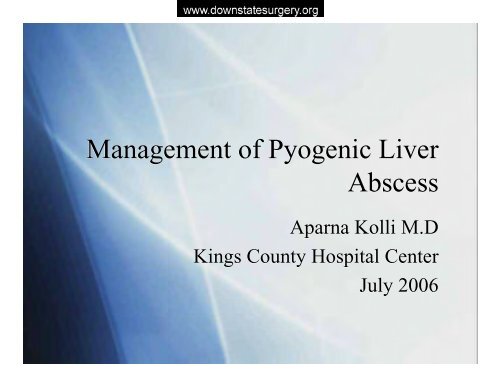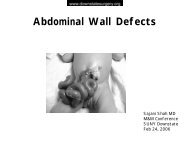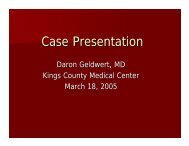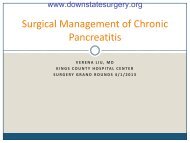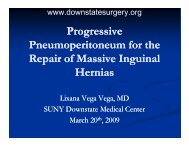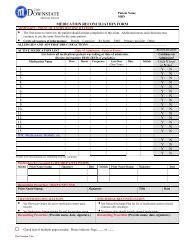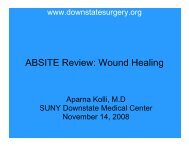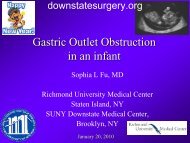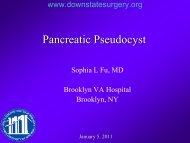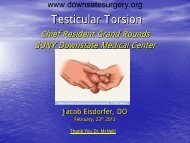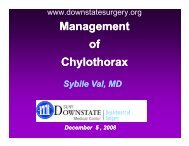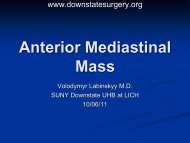Management of Pyogenic Liver Abscess
Management of Pyogenic Liver Abscess
Management of Pyogenic Liver Abscess
You also want an ePaper? Increase the reach of your titles
YUMPU automatically turns print PDFs into web optimized ePapers that Google loves.
<strong>Management</strong> <strong>of</strong> <strong>Pyogenic</strong> <strong>Liver</strong><br />
<strong>Abscess</strong><br />
Aparna Kolli M.D<br />
Kings County Hospital Center<br />
July 2006
HPI<br />
• xx yo male inpatient in the Psychiatric ward<br />
complaining <strong>of</strong> fever, right sided abdominal pain<br />
and discharge from his umbilicus<br />
• Denied any N/V/D or chills<br />
• NKDA<br />
• PMHx: schizophrenia, DM, obesity<br />
• PSxHx: denies<br />
• SocHx: negative
Physical Exam<br />
• General: NAD, lying in bed<br />
• CVS: tachycardic<br />
• Chest: bibasilar decreased breath sounds<br />
• Abd: obese, s<strong>of</strong>t, mildly distended, RUQ<br />
tenderness on palpation, +voluntary<br />
guarding, no rebound, +purulent discharge<br />
from umbilicus<br />
• Ext: +pedal edema
Vitals and Laboratory Values<br />
• Tm: 101.4<br />
• BP: 154/87<br />
• HR: 105<br />
• WBC: 13.7; PMN:<br />
48%<br />
• H/H: 11.4/36.4<br />
• Lactate: 1.4<br />
• AlkPhos: 192<br />
• AST/ALT: 57/70<br />
• Tbili: 0.5<br />
• PT/PTT/INR:<br />
15.5/23.3/1.6
Hospital Course<br />
• Patient emergently transferred to the SICU<br />
• CT Abd/Pelvis performed<br />
• Multiple intraabdominal abscesses and<br />
significant amount <strong>of</strong> free air<br />
• Resuscitated and emergently taken to OR
Imaging Studies
Imaging Studies
Imaging Studies
OR Course<br />
• Significant intraabdominal pus<br />
• Dense adhesions<br />
• Sealed <strong>of</strong>f perforation at appendix tip<br />
• Large friable abscess on superior right liver lobe<br />
• <strong>Abscess</strong> dero<strong>of</strong>ed with drainage <strong>of</strong> >1liter <strong>of</strong> pus<br />
• Abdomen irrigated<br />
• 2 sump drains and a JP left in place
<strong>Management</strong> <strong>of</strong> <strong>Pyogenic</strong> <strong>Liver</strong><br />
<strong>Abscess</strong>
Historical Perspective<br />
• First comprehensive study was done by Ochsner<br />
and DeBakey in 1938<br />
• Historically liver abscesses developed in young,<br />
healthy patients with an intraabdominal infection,<br />
most likely secondary to acute appendicitis<br />
• Demographics have changed significantly over<br />
past four decades with the improvement in<br />
operative techniques and advent <strong>of</strong> antibiotics
• Overall incidence<br />
increased from<br />
13/100,000 to<br />
20/100,000 hospital<br />
admissions over<br />
twenty year period<br />
Epidemiology<br />
Huang et al., <strong>Pyogenic</strong> Hepatic <strong>Abscess</strong>: Changing Trends Over 42 Years, Annals <strong>of</strong><br />
Surgery, 1996; 5:600-609
Pathogenesis <strong>of</strong> the disease<br />
• <strong>Liver</strong> regularly exposed to<br />
bacteria via portal<br />
circulation<br />
• Routine clearance occurs<br />
without incidence<br />
• <strong>Abscess</strong> occurs when the<br />
inoculum <strong>of</strong> bacteria<br />
exceeds the liver’s ability<br />
to clear the bacteria
Pathogenesis <strong>of</strong> the disease<br />
• Routes <strong>of</strong> Infection<br />
• Via biliary tree<br />
• Via portal vein<br />
• Via hepatic artery<br />
• Direct extension from a<br />
nearby focus <strong>of</strong><br />
infection<br />
• Blunt or penetrating<br />
trauma<br />
• Obscure origin<br />
Huang et al., <strong>Pyogenic</strong> Hepatic <strong>Abscess</strong>: Changing Trends Over 42 Years, Annals <strong>of</strong><br />
Surgery, 1996; 5:600-609
Pathogenesis <strong>of</strong> the disease<br />
• Routes <strong>of</strong> Infection<br />
• Via biliary tree<br />
Huang et al., <strong>Pyogenic</strong> Hepatic <strong>Abscess</strong>: Changing Trends Over 42 Years, Annals <strong>of</strong><br />
Surgery, 1996; 5:600-609
Pathogenesis <strong>of</strong> the disease<br />
• Routes <strong>of</strong> Infection<br />
• Via biliary tree<br />
• Via portal vein<br />
Huang et al., <strong>Pyogenic</strong> Hepatic <strong>Abscess</strong>: Changing Trends Over 42 Years, Annals <strong>of</strong><br />
Surgery, 1996; 5:600-609
Pathogenesis <strong>of</strong> the disease<br />
• Routes <strong>of</strong> Infection<br />
• Via biliary tree<br />
• Via portal vein<br />
• Via hepatic artery<br />
Huang et al., <strong>Pyogenic</strong> Hepatic <strong>Abscess</strong>: Changing Trends Over 42 Years, Annals <strong>of</strong><br />
Surgery, 1996; 5:600-609
Pathogenesis <strong>of</strong> the disease<br />
• Routes <strong>of</strong> Infection<br />
• Via biliary tree<br />
• Via portal vein<br />
• Via hepatic artery<br />
• Direct extension from a nearby focus <strong>of</strong><br />
infection<br />
Huang et al., <strong>Pyogenic</strong> Hepatic <strong>Abscess</strong>: Changing Trends Over 42 Years, Annals <strong>of</strong><br />
Surgery, 1996; 5:600-609
Pathogenesis <strong>of</strong> the disease<br />
• Routes <strong>of</strong> Infection<br />
• Via biliary tree<br />
• Via portal vein<br />
• Via hepatic artery<br />
• Direct extension from a nearby focus <strong>of</strong><br />
infection<br />
• Blunt or penetrating trauma<br />
Huang et al., <strong>Pyogenic</strong> Hepatic <strong>Abscess</strong>: Changing Trends Over 42 Years, Annals <strong>of</strong><br />
Surgery, 1996; 5:600-609
Pathogenesis <strong>of</strong> the disease<br />
• Routes <strong>of</strong> Infection<br />
• Via biliary tree<br />
• Via portal vein<br />
• Via hepatic artery<br />
• Direct extension from a nearby focus <strong>of</strong><br />
infection<br />
• Blunt or penetrating trauma<br />
• Obscure origin<br />
Huang et al., <strong>Pyogenic</strong> Hepatic <strong>Abscess</strong>: Changing Trends Over 42 Years, Annals <strong>of</strong><br />
Surgery, 1996; 5:600-609
Underlying Etiology<br />
• Biliary pathology 27.1%<br />
• Hepatic cirrhosis 3.7%<br />
• Hepatocellular carcinoma 2.8%<br />
• Ruptured appendicitis 0.9%<br />
• Colon diverticulitis 0.9%<br />
• Ampullary carcinoma 0.9%<br />
• Metastatic liver tumors 0.9%<br />
Chan et al., <strong>Pyogenic</strong> <strong>Liver</strong> <strong>Abscess</strong>: A Retrospective Analysis <strong>of</strong> 107<br />
Patients During a 3-Year Period, Japanese Journal <strong>of</strong> Infectious Disease,<br />
2005; 58: 366-368
Characteristics <strong>of</strong> Infection<br />
• Right lobe involvement 75%<br />
• Left lobe involvement 20%<br />
• Caudate lobe involvement 5%<br />
• Bilobar involvement uncommon<br />
• Solitary abscess 50%<br />
• Size <strong>of</strong> abscess varies from
Characteristics <strong>of</strong> Infection<br />
• Gross appearance:<br />
• Tan, fluctuant structure<br />
• May cause local<br />
adhesion secondary to<br />
inflammation
Microbiology<br />
• Microbiology <strong>of</strong> abscess reflects source<br />
• <strong>Abscess</strong>es due to pyelophlebitis or cholangitis<br />
tend to be polymicrobial<br />
• 40% are polymicrobial<br />
• Majority are solitary<br />
• Isolated organisms include: Enterococci and<br />
streptococci<br />
• <strong>Abscess</strong>es due to systemic infection tend to be<br />
monomicrobial<br />
• Most commonly staphylococcal species
Microbiology <strong>of</strong> Infection<br />
• Most common organisms cultured are:<br />
• Klebsiella pneumonia and E. coli<br />
• Other organisms include:<br />
• Staphylococcus aureus, enterococcus, streptococcus<br />
viridans and bacteroides species<br />
• Uncommon organisms encountered:<br />
• pseudomonas, proteus, enterobacter, citrobacter,<br />
serratia, ß-hemolytic strep, microaerophilic strep,<br />
fusobacterium, clostridium and other rare anaerobes<br />
• Fungal and mycobacterial hepatic abscesses are<br />
rare and are associated with immunosuppression<br />
Lee et al., <strong>Pyogenic</strong> <strong>Liver</strong> <strong>Abscess</strong>: An Audit <strong>of</strong> 10 Years’ Experience And Analysis<br />
<strong>of</strong> Risk Factors, Digestive Surgery, 2001; 18:459-466
Microbiology <strong>of</strong> Infection<br />
Lee et al., <strong>Pyogenic</strong> <strong>Liver</strong> <strong>Abscess</strong>: An Audit <strong>of</strong> 10 Years’ Experience And<br />
Analysis <strong>of</strong> Risk Factors, Digestive Surgery, 2001; 18:459-466
Clinical Presentation<br />
• Classic presentation <strong>of</strong><br />
fever, jaundice, RUQ pain<br />
and tenderness occurs in<br />
only 10% <strong>of</strong> the cases<br />
• Most common presenting<br />
symptoms include<br />
• fever, chills, abdominal pain<br />
• Other common findings:<br />
• Anorexia, weight loss,<br />
hepatomegaly<br />
• Rupture presents with<br />
peritonitis<br />
Sign/Symptom No. %<br />
Initial complaint<br />
Fever/chills 31 38<br />
Abdominal pain 29 16<br />
Anorexia/malaise 9 12<br />
Symptoms<br />
Fever/chills 55 75<br />
Anorexia/malaise 42 58<br />
Abdominal pain 40 55<br />
Nausea/vomiting 20 27<br />
Weight loss 21 29<br />
Night sweats 7 10<br />
Diarrhea 6 8<br />
Signs<br />
Fever (T> 38) 45 61<br />
Hepatomegaly 28 38<br />
RUQ tenderness 26 36<br />
Weight loss 23 31<br />
Right basilar rales 18 25<br />
Jaundice 17 23<br />
Diffuse abdmominal tenderness 11 15<br />
Ascites 3 4<br />
Branum et al., Hepatic <strong>Abscess</strong>: Changes in Etiology, Diagnosis, and <strong>Management</strong>,<br />
Annals <strong>of</strong> Surgery; 1989, 212: 655-662
Laboratory Findings<br />
• Typically nonspecific however, leukocytosis is<br />
present in up to 90% <strong>of</strong> the cases<br />
• Abnormal LFTs are <strong>of</strong>ten present and usually<br />
reflect underlying biliary disease<br />
• AlkPhos levels are mildly elevated in 70-80% <strong>of</strong> the cases<br />
• Tbili is elevated in approximately 20% <strong>of</strong> the cases<br />
• Transaminases may also be mildly elevated<br />
• None <strong>of</strong> these blood tests are diagnostic <strong>of</strong> hepatic<br />
abscesses but because they reflect a hepatic<br />
abnormality, imaging studies may be prompted<br />
Lee et al., <strong>Pyogenic</strong> <strong>Liver</strong> <strong>Abscess</strong>: An Audit <strong>of</strong> 10 Years’ Experience And<br />
Analysis <strong>of</strong> Risk Factors, Digestive Surgery, 2001; 18:459-466
Imaging Studies<br />
• CXR:<br />
• Abnormal approximately<br />
50% <strong>of</strong> the time<br />
• Reflects subdiaphragmatic<br />
process<br />
• may present as an elevated<br />
right hemidiaphragm<br />
• right pleural effusion<br />
• atelectasis
Imaging Studies<br />
• Radionuclide Scans:<br />
• Technetium-99m sulfur<br />
colloid scans used<br />
historically<br />
• Identifies an abscess based<br />
on differential activity <strong>of</strong><br />
the cells within the abscess<br />
and the surrounding cells<br />
• Limited by its inability to<br />
detect lesions < 2cm
Imaging Studies<br />
• Ultrasound:<br />
• 80-95% sensitive<br />
• Demonstrates round/oval<br />
hypogenic area<br />
• Better visualization <strong>of</strong> biliary<br />
tree<br />
• Distinguishes solid from<br />
cystic lesions<br />
• Limitations:<br />
• poor visualization liver dome<br />
• user-dependent<br />
• inadequate for obese habitus
Imaging Studies<br />
• CT scan:<br />
• 95-100% sensitive<br />
• Gold standard<br />
• Hypoattenuated lesions<br />
in comparison to the<br />
liver parenchyma<br />
• Able to visualize<br />
microabscesses
Differential Diagnosis<br />
• amebic abscesses<br />
• echinococcal cysts<br />
• Echinococcal cysts distinguished by:<br />
• history<br />
• characteristic radiological findings<br />
• However, presentation <strong>of</strong> amebic and<br />
pyogenic abscesses are nearly identical
Amebic vs. <strong>Pyogenic</strong> <strong>Liver</strong><br />
<strong>Abscess</strong><br />
Clinical Features Amebic <strong>Abscess</strong> <strong>Pyogenic</strong> <strong>Abscess</strong><br />
Age 20-40 >50<br />
Male:Female ratio >10:1 1.5:1<br />
Solitary vs. multiple Solitary>80% Solitary 50%<br />
Location Usually right liver Usually right liver<br />
Travel in endemic area Yes No<br />
Diabetes Uncommon More common<br />
Alcohol use Yes Yes<br />
Jaundice Rare Common<br />
Elevated bilirubin Uncommon Common<br />
Elevated AlkPhos Common Common<br />
Positive Blood culture No Common<br />
Positive amebic serology Yes<br />
No
Treatment<br />
• Untreated pyogenic abscesses are uniformly fatal<br />
• Survival rate has improved from 20% in 1938 to<br />
approximately 80% presently<br />
• Primary goal in treatment:<br />
• eliminate both the abscess and the underlying source<br />
• typically accomplished by a combination <strong>of</strong> IV<br />
antibiotics and abscess drainage
Treatment<br />
• Initial treatment with empiric antibiotics<br />
• Broad spectrum antibiotics with metronidazole<br />
until pyogenic abscess is confirmed<br />
• Antibiotic therapy adjusted to isolated organisms<br />
• Duration <strong>of</strong> antibiotic therapy not well-defined<br />
• 6 weeks <strong>of</strong> parenteral therapy is commonly advocated
Percutaneous Drainage<br />
• First description <strong>of</strong> percutaneous drainage <strong>of</strong><br />
pyogenic liver abscess by McFadzean et al. in<br />
1953<br />
• Efficacy and safety <strong>of</strong> percutaneous drainage<br />
established by mid-1980s<br />
• Percutaneous drainage is now the primary<br />
modality for drainage <strong>of</strong> pyogenic liver abscess
Percutaneous Drainage:<br />
Advantages and Disadvantages<br />
• Advantages:<br />
• Avoids general<br />
anesthesia<br />
• Shorter hospitalization<br />
• Well tolerated<br />
• Disadvantages:<br />
• High failure rate (30%)<br />
• Failures secondary to:<br />
• thick-walled abscess<br />
• viscid pus<br />
• presence <strong>of</strong> loculations<br />
• Not indicated in the<br />
presence <strong>of</strong> ascites or<br />
abscess in close<br />
proximity to pleura<br />
Herman et al., <strong>Pyogenic</strong> <strong>Liver</strong> <strong>Abscess</strong>: The Role <strong>of</strong> Surgical Treatment,<br />
International Surgery, 1997; 82: 98-101
Surgical Drainage<br />
• Presently reserved for:<br />
• Failed percutaneous drainage<br />
• Patients who have a contraindication to<br />
percutaneous drainage<br />
• Patients who require surgical management <strong>of</strong> an<br />
underlying problem<br />
• Multiple or loculated abscesses
Surgical Drainage<br />
• Historical route <strong>of</strong> extraperitoneal drainage<br />
dictated by the position <strong>of</strong> the abscess<br />
• Anterior abscesses approached through a<br />
subcostal incision<br />
• Posterior abscesses approached using a<br />
posterior retroperitoneal incision through the<br />
bed <strong>of</strong> the twelfth rib<br />
• A transpleural approach for “high-lying”lesions<br />
has been described
Transperitoneal Drainage<br />
• Advantages include:<br />
• Ability to explore the entire abdominal cavity and<br />
locate the primary source <strong>of</strong> infection<br />
• Full exposure <strong>of</strong> the liver<br />
• Determination best drainage site<br />
• Ability to locate multiple abscesses<br />
• Intraoperative ultrasound allows:<br />
• localization <strong>of</strong> the abscess<br />
• guidance for adequate and precise drainage<br />
• avoids damage to the liver parenchyma
Catheter Drainage vs. Needle<br />
Aspiration<br />
• Continuous catheter drainage<br />
• widely accepted mode <strong>of</strong> IR drainage<br />
• Yu et al (2004) conducted a 5-year<br />
prospective randomized comparison <strong>of</strong> the<br />
two modalities
Catheter Drainage vs. Needle<br />
Aspiration<br />
• Needle aspiration:<br />
• Treatment success rate 97%<br />
• Low mortality (3%)<br />
• Decreased length <strong>of</strong> hospitalization<br />
• Disadvantage: multiple aspirations required<br />
Yu et al, Treatment <strong>of</strong> <strong>Pyogenic</strong> <strong>Liver</strong> <strong>Abscess</strong>: Prospective Randomized<br />
Comparison <strong>of</strong> Catheter Drainage and Needle Aspiration, Hepatology, 2004;<br />
39(4): 932 - 938
Summary<br />
• Most frequently occurs in 5 th decade<br />
• Most common underlying etiology<br />
• Biliary pathology<br />
• Most commonly isolated organism<br />
• Klebsiella and E. coli<br />
• Antibiotics and percutaneous drainage are the<br />
mainstay <strong>of</strong> treatment<br />
• Needle aspiration and continuous catheter drainage are<br />
safe and effective
Summary<br />
• Surgical drainage reserved for:<br />
• Failed percutaneous drainage<br />
• Contraindication to percutaneous drainage<br />
• Surgical management <strong>of</strong> an underlying problem<br />
• Multiple or loculated abscesses


